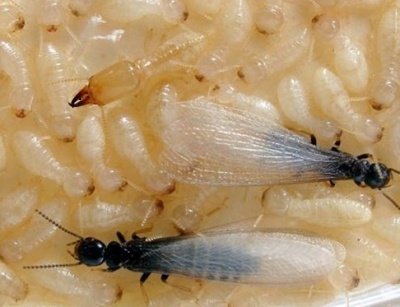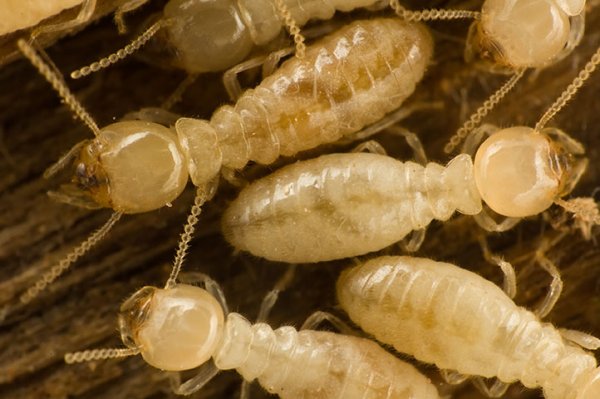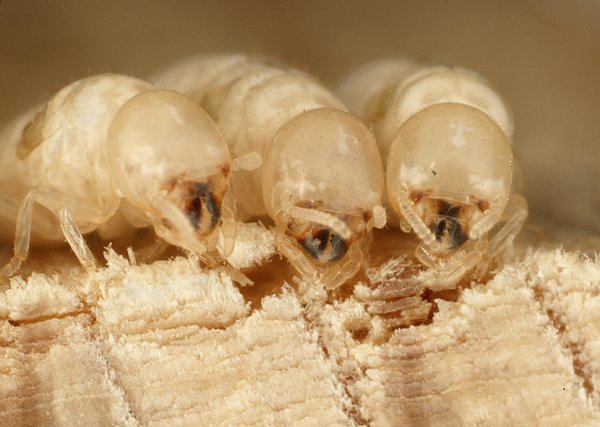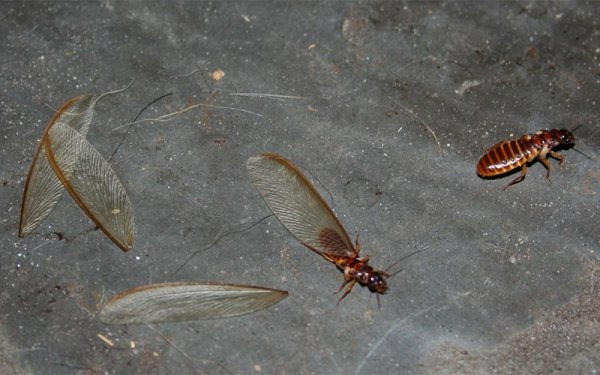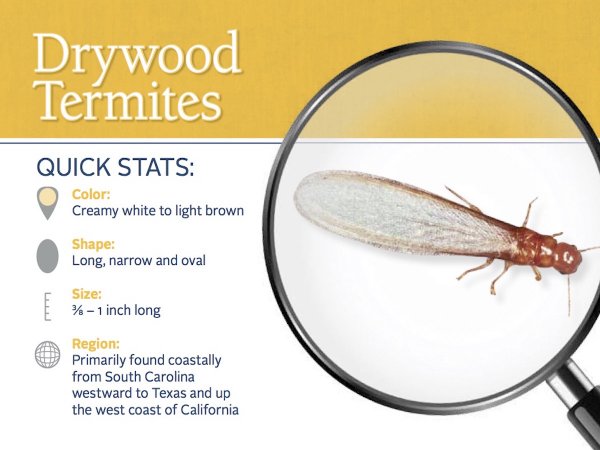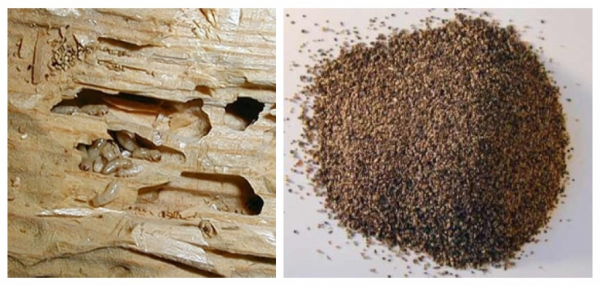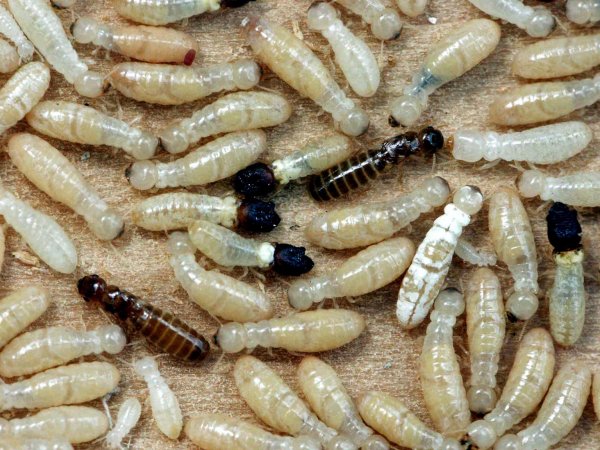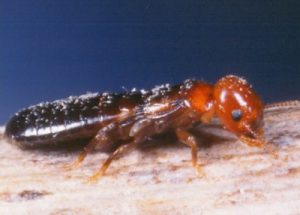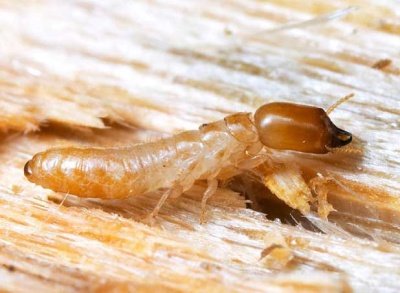 The drywood termite is the most usual pest damaging properties in United States.
The drywood termite is the most usual pest damaging properties in United States.
Though less economically exhausting as the subterranean termites’ family and especially the Formosan termite, the drywood species are a source of headache for the homeowners of southwest states and cost the US economy $1.7 billion every year in damages and cost of pest control.
Drywood termite is a social insect, living in a colony that originates from a single pair of male and female.
The proper name for the drywood termites’ family is Kalitermitidae. There are plenty of differences between drywood and subterranean termites families.
Hide content
- Colony structure
- The colony
- Identification
- Signs of infestation
- Treatment
- Helpful video
- Conclusion
Colony structure
What are drywood termites? Like any other termite species, the drywood have several casts in their colonies:
The reproductive cast includes:
Workers of the drywood termites are not completely separated as it is in more developed system of the colony of subterranean termite.
Instead, the functions of workers fulfill pseudergates (“false workers’) which are basically the immature termites, that can later develop into soldiers or reproductives, so their role as workers is temporary.But the nature of the job is the same – false or not, the workers are the foraging cast of the colony. Their role is to feed the other members of the colony, and as their food is cellulose, the workers are the main threat to the wooden structures.
How big are drywood termites? The workers of drywood termite have no wings, and are about 0.6-0.9 cm and have pale beige color.
The dry wood is a diet which is rather hard to bite, and for this reason the workers of drywood termite are fortified with the mandibles (jaws) that have zinc in their tissue to adapt to the hard source of food.
That makes them capable of going through the hard summer wood, though the soft spring growth normally is being eaten first.
Soldiers are the warriors; they protect the colony from outside danger – mostly other termite species or ants. The size of their light brown body is usually up to 1 cm.
The reproductives are the winged termites (alates), which form the swarms on the warm sunny days, emerging in thousands from the holes in the wood and loose wings as soon as they find a place to land.
Different drywood species vary in habitual swarming time and conditions, most of them prefer dusk or night time for a flight, but there are some for example dark western drywood termite, that prefer the day time.
The swarmer termites are around 1,2 cm in length and have pale brown color, the wings add up to 0,5 cm to their length and are varying in color from smoke gray to almost clear.
The shape of the body is cylindrical. Alates have six legs and start hatching only in mature colonies.
As the other termite families swarmers, the alates of the drywood termite are attracted by light, so there is a chance to find them alive or dead alates around areas well-lit in the house: on the window and door sills, for example.If you find any broken wings in this zones – there is a chance your house is infested by termites. The alates are very bad flyers, so unless they are carried away by the wind, they don’t travel a great distance.
Very few are surviving to have a chance in establishing a new colony. Most of the swarm is being eaten by birds, toads, reptiles and other insects. Many die due to dehydration or injury.
Drywood termite life cycle consists of several stages. Once the winged termite lands it sheds off its wings, searches for a pair and if lucky finds a new colony, where it and its mate become the new queen and the king who will be the only ones to reproduce in the nest.
In few weeks the first immatures will hatch from the eggs and will be taken care by king and queen. The first immatures take on the role of the workers after couple of molts and from this moment start to feed the royal couple.
The first year very few drywood termite eggs are laid by the queen, and as she matures, she starts laying more. If the drywood termite queen dies – the secondary reproductive will take on her place.
Learn more about how do flying termites look like and what to do if there are alates in the house?
The colony
Usually the colonies are small in size and it can be as little as 50 members in it the first year. The fully developed colony in 3-4 years will reach around 700 individuals, that’s the moment it can start releasing the swarms of alates.
Some of the biggest colonies after 15 years might reach the member count of 3000 individuals, but the colony of this size is very rare.
Unlike the subterranean termites, the drywood species do not need the soil for nesting.
They usually form a colony in the wooden structure itself.
The only thing they need is a dry dead wood, as they have an adaptive mechanism to conserve the water in their bodies.
The material which wasn’t digested passes through their specialized rectal glands and this allows the organism to reabsorb the moisture from the feces.
That why drywood termites are surviving easily even such rough conditions as hellishly dry areas in southern California. As the colony is normally small in its size, the termites might use for nesting utility poles, lumber storages, posts and furniture.More info about where to find their nests?
Identification
How to identify drywood termites? Drywood termite identification is not an easy task. The worker termites cannot be clearly identified and it’s a popular misconception that they can be told from the workers of the subterranean termite by their size.
To know for sure, you will need the soldiers or alates. The soldiers are really hard to find – there aren’t many in the colony. It is bigger than the worker termite and has large toothed mandibles on its brownish head.
The alates of the drywood termite are very similar to the swarmers of the Formosan subterranean termite, so you need to be very accurate with the identification. They have the same color and size, and a very close vein drawing on the wings.
So the difference is the three major veins instead of two on the wings of the drywood termite and generally many crossed veins, comparing to the few ones on the wings of Formosan termite.
Also, the drywood swarmers have thinly dispersed hair on wings unlike the Formosan reproductives whose wings are covered in small hair.
Obviously it’s really hard to make a proper identification yourself, so the best way of doing it would be collecting the termites and bringing them to the pest control specialists. The best is to bring the whole termite, but even just the wings can give you chances to identify which species is infesting your property.Photo
What do drywood termites look like? Pictures of drywood termites:
Signs of infestation
You can suspect that your building is infested with termites if you noticed one or several of these signs:
- Frass. Find out if it is toxic for human?
- Alates, dead or alive, wings.
- Damaged wood.
Frass is essentially drywood termite feces, produced in the process of digesting the wood and being evacuated from the nest tunnels through the ‘kick holes” in infested wood.
They normally are gathered in small piles on the window and door sills and on the wooden porches, and resemble a lot to sawdust.
If you’re not sure to tell one from another check these moments:
- Check with the magnifying glass the shape of the pellets. The feces will be 6-sided granular shape.
- Also the color of frass grains will vary slightly and the saw dust elements will be equal in shade.
- Just think for a minute “why there could be any sawdust here?” and if the answer is “no reason”, then you might be looking at frass.
Here you can learn more information about the signs of termites outside and in the house: in walls or wooden items.The individual swarmers found around the windows, in spider webs or anywhere else around the house are an indication of the infestation, as well as the shed wings. The problem with it is that the presence of the alates means a fully grown colony nearby and basically shows that you already skipped the best moment to prevent the drywood termite damage.
If you suspect any damaged wood in your house it’s very easy to check. Tap on the wooden structures with the end of the screwdriver and if you hear a hollow sound – you’ve found what you were searching for.
To inspect the house properly for the signs of infestation prepare to spend a lot of time. You will need to check every wooden surface outside and inside the house, do not discard any places, even such as closed drawers or the back panels of the cupboard or a dresser.
Sometimes the infested wood surface might look blistered if it was painted, but mostly there’ll be no outer signs.
If you found an area damaged by termites, tap on the boards following the hollows until the hard wood starts again. Often removing the infested wood or burning termite-eaten furniture is all you need to do to get rid of the termites’ colony within your house.
If you interested, read more about what does termite damage look like: in walls and wood floors.
Treatment
How to prevent drywood termites? Generally, you have three options for treatment for drywood termites:
- No action (if the area and damage is small).
- Wood replacement or spot treatment.
- Fumigation.
If the first two can be done all by yourself, the last one will require help from a professional pest control specialist, so what you have to do is to find a reputable organization nearby and keep it in your contact list.
Find out the best methods of a drywood termites treatment.
Important! Having a contract with the pest control office can get your house checked every now and then without extra payment.Helpful video
In this video you will see some drywood termite prevention measures:
Conclusion
Drywood termites can create a lot of problems, but as the size of the colony usually isn’t too big, the destruction they cause is quite local and can be managed or even prevented.
All you have to do is to keep it under check and don’t let the situation go out of control and you will win your war against insects without any active battle.
